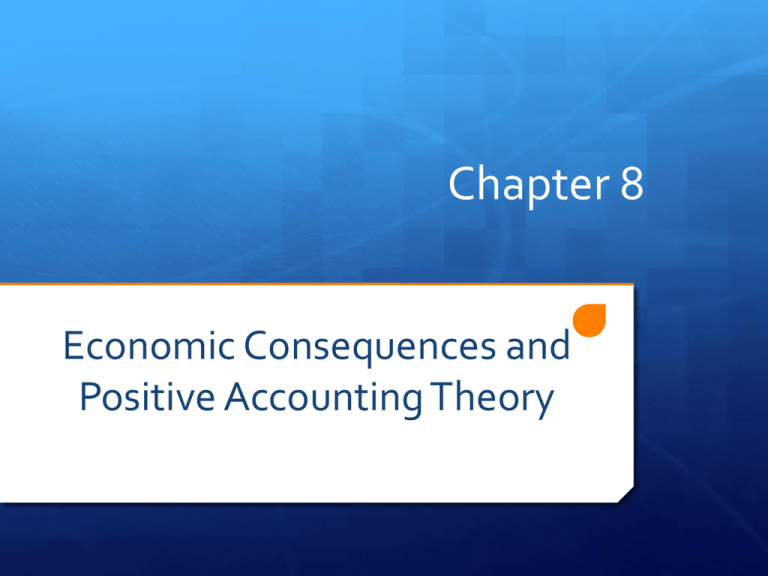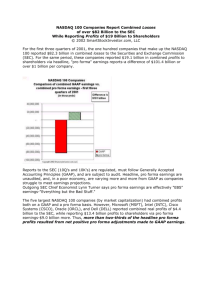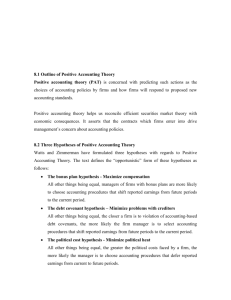Chapter_8-_powerpointx
advertisement

Chapter 8 Economic Consequences and Positive Accounting Theory Agenda Employee stock options Positive Accounting Theory (PAT) Bonus plan hypothesis Debt covenant hypothesis Political cost hypothesis Empirical research Opportunistic versus efficient contracting versions of PAT eToys Inc: A Case Examining Pro Forma Financial Reports, Analysts’ Forecasts and Going Concerns Disclosures Terminology Economic Consequences: A concept asserts that, despite the implication of efficient securities market theory, accounting policy choice can affect firm value Positive Accounting Theory: Theory that attempts to predict what accounting policies managers will choose in order to maximize the firm’s interests relative to executive compensation contacts or debt contracts The Rise of the Economic Consequences Stephen Zeff – 1978 “The impact of accounting reports on decision-making behaviour of business, government and creditors” “Replacement costs accounting” => third-party intervention/management, attempted to reduce earnings Lower taxes & wages increase Cover to the public perception of excessive profitability The Rise of the Economic Consequences Assumption: Market efficiency Non-ideal condition: net income is not well-defined Conclusion: Governance bodies of accounting standard must must balance both the accounting and political domains Refers to as “delicate balancing act” Questions What is Employee Stock Options (EPOs)? What is grant date? What is vesting period? What is the intrinsic value mean? Why do you think it is important to understand the EPOs? Employee Stock Options (EPS) Accounting Principles Board (APB 25) Intrinsic Value = Market Value(Grant Date) – Exercise Price Increase in trend when using the EPS since 1972 Ex: High-tech start-up firms Fail to record expenses, overstated net income Black/Scholes Formula Black/Scholes Formula’s Flaws Not transferable Cannot exercise until the vesting date (1 to 2 years after the grant date) If resigned before the vesting date, options may became forfeit Not exercise until the expiry date (European option) Ex ante Value Recorded expenses based on the fair value at the grant date Known as “ex ante value” With adjustment for the probability when employee exercise based on the expected time to exercise Based on the past experience rather than the time to expiry Fair market value estimated by Black/Scholes or others formulas Opposition to Ex ante Value Extended this matter to US congress Lower share prices Higher cost of capital Shortage of managerial talent Inadequate manager and employee motivation Adjusted Black/Scholes… Requires no cash flow Employees are diluted the interested of existing shareholders by purchasing shares at a discount Opportunity costs = ex post value Example Ex ante is the present value of the ex post value Adjusted Black/Scholes… Increase in relevancy Decrease in reliability Decrease in earning due to the increase in expenses Better prediction of the future cash flows Huddart (1994) Employee’s optional exercise strategy Assumptions: no dividends and no motivation impact Claimed that Black/Scholes formula is indeed overstated the fair value of the an ESO at the grant date Assuming the option is heard to expiry date Two circumstances lead to exercising the option early Huddart : Early-Exercise If the ESO is slightly-in-money (probability of payoff might be zero) Time to maturity is short Employees are required to hold the share that acquired Risk averse employees might exercise the options early If the ESO is deep-in-money (probability of payoff is high) Time to maturity is short Risk averse employees might be more likely to sell the shares and buy something less risky to invest Huddart: Empirical Studies 8 large U.S. corporations over a 10-year period Early time to expiration Whether the options are in-the-money or not Other studied => same result Hall and Murphy (2002), Different approaches Marquard (2002), 966 options, 57 companies, 21 years Governance Body of Accounting Proposed to use the expected time to exercise as suppose to expiry date Huddart Conclusion ESO fair value maybe unreliable because of the upward bias and possible error and bias in estimating the timing of employee’s early exercise decision Tactic to Manipulate Share Prices Pump and dump: management intervention to increase the share price temporally Studied: Bartov and Mohanram (2004), 1218 US, 9 years Scheduled grant dates options BN (Bad news), lower the share prices, thus lower the exercise price Studied: Aboody and Kasznik (2000) Unscheduled grant dates Studied: Baker, Collins and Reitenga (2009) Lower earning: Write off large assets / accrued large ceiling test Tactic to Manipulate Share Prices “Spring loading”, Unscheduled ESOs CEO would pressure compensation committees to grant unscheduled ESOs shortly before good news Studied: Yermack (1997) “Late timing”, backdating of ESO awards to be lower than the grant date Intrinsic value was positive, violate GAAP and SEC Studied: Bernil and Jarrell (2009), 129 firms Outcome Affective in 2005, SFAS 123 R, IFRS 2 of the IASB required the firm to expense the ex ante ESO cost Resulted in a great reduction in the usage of ESOs compensation device From 2000 to 2005, ESOs fell from 104 billions to only 30 billions Relationship between ESMT and Economic Consequences ESMT doesn’t work if accounting policies changes don’t impact underlying profitability and cash flow APs are matter even without the cash flow effects APs have the potential real management decisions Positive Accounting Theory Outline of PAT Concept Maximizing firms’ prospects for survival Nexus of the contracts they have entered into Positive Accounting Theory Outline of PAT Choosing APs -- need for minimize the contract costs Problem of attaining efficient corporate governance Changing circumstances require managers to have flexibility in choosing APs Wouldn’t tell individuals or what they should do Positive Accounting Theory Three Hypotheses (1) Bonus plan hypothesis (2) Debt covenant hypothesis (3) Political cost hypothesis Positive Accounting Theory Three Hypotheses (1) Bonus plan hypothesis Concept The hypothesis seems reasonable If manager is risk-averse – smooth reported earning comes out Positive Accounting Theory Three Hypotheses (2) Debt covenant hypothesis Concept Why we do this hypothesis? The manager may object to accounting policies that increase earnings volatility Positive Accounting Theory Three Hypotheses (3) Political cost hypothesis Concept It introduces a concept into accounting political choice Firms may face political costs at particular points in time Conclusion They are important component of PAT and can be interpreted from an efficient contracting or stewardship perspective Efficient Contracting and Conservative Accounting CA requires a high degree of verification before making a legal claim to any profit The questions about conservative accounting in debt contracts are raised The demand for conservative accounting may decrease Recap 1. What are the three hypotheses under PAT? 2. Could you generally state the concept of PAT? 3. Under the hypothesis, why do the manager object to accounting policies when the probability of earnings volatility is increase? Empirical PAT Research Bonus plan hypothesis – Healy 1985 Dept covenant hypothesis – Dichev and Skinner 2002 Covenant slack – difference between firm’s actual current ratio at the end of quarter and current ratio firm is required to maintain under agreement Zero or positive slack Initial violations Political cost hypothesis – Jones 1991 International Trade Commission (ITC) Lower reported net income Political Cost Hypothesis – Jones 1991 Discretionary accruals Increasing amortization charges Recording excessive liabilities for product guarantees, contingencies, and rebates Recording generous provisions for doubtful accounts and obsolescence of inventories Calculating firm’s total accruals for the year: Change in non-cash working capital for the year from the comparative balance sheets, plus amortization expense Discretionary versus non-discretionary Regression Equation Prior to ITC Tajt = αj + β1jΔREVjt + β2jPPEjt + Єjt TAjt = total accruals for firm j in year t ΔREVjt = revenues for firm j in year t less revenues for year t -1 PPEjt = gross property, plant, and equipment for firm j in year t Єjt = a residual term that captures all impacts on TAjt other than those from ΔREVjt and PPEjt αj, β1j, and β2j are constants Regression Equation During ITC Ujp = TAjp - (αj + β1jΔREVjp + β2jPPEjp) p is the year of investigation TAjp is firm j’s total accruals for this year Quantity in brackets = non-discretionary accruals for the year Ujp = an estimate of discretionary accruals for year p for firm j Jones (1991) Expected: Ujp will be negative firm is using discretionary accruals to reduce reported net income Results: Discretionary accruals were significantly negative in the ITC investigation years Chose accrual policies so as to improve their case Opportunistic Versus Efficient Contracting Opportunistic form Maximize own expected utility Efficiency form Compensation contracts and internal control systems limit opportunism Motivate managers to control costs Benefits the firm and its shareholders Opportunism or Efficiency Mian and Smith Study Christie and Zimmerman (1994) Income-increasing Takeover targets Dechow (1994) Net income more highly associated with returns than cash flow Dichev and Skinner (2002) Variability over time of each firm’s covenant ratios Opportunism or Efficiency Continued Guay (1999) Studied derivatives activities Reduce firm-specific price risks Take on other firm-specific risks that are in the shareholders’ interests R&D, exploration, and new investment Guay (1999) Hedging is consistent with efficient contracting Firms experienced a significant reduction in several measures of firm risk relative to a control sample of firms that did not use derivatives Consistency between type of risk exposure and type of hedging instrument used. Interest rate swaps = agreement between two parties where one stream of future interest payments is exchanged for another based on a specified principal amount. Opportunism or Efficiency Continued Hope and Thomas Study Multinational firms under SFAS 131 Disclose foreign earnings By geographic area is voluntary Increased foreign sales Decreased total foreign earnings “Empire building” – increase firm size; growing firm Behaving opportunistically Opportunism or Efficiency Continued Armstrong, Jagolinzer, and Larcker (AJL) – 2010 Efficient contracting CEO’s “portfolio delta” Change in value of CEO’s holdings of stock and options following a $1 change in share price Identified similar firms CEO’s had differing portfolio delta No evidence high portfolio delta cause opportunistic behaviour Therefore, efficient contracting Conclusions on Economic Consequences and PAT Accounting policies matter PAT understands and predicts accounting policy choices Minimize costs Determined by organizational structure (determined by environment) Large set of accounting policies is efficient New standards interfering and management reactions Aligning management and shareholders’ interests eToys Inc.: A Case Examining Pro Forma Financial Reports, Analysts’ Forecasts & Going Concern Disclosures Case Overview Internet toy company that was modelled after Amazon Pubic in 1999 & lost $190M in 2000 by spending more than they earned Important Issues: Cost Control Recording Acquisitions & Goodwill Raising Capital Going Concern Press Releases using Pro Forma Analysts’ Forecasts The Early Years (1997-March 2000) Toby Lenk – Economics Graduate - Walt Disney – 9 years Followed model for Amazon & Barnes/Nobel to have online only toy store Advantage: first to have online toy website Revenue: 500K to 30M (Loss?) Acquired BabyCenter – July 1 1999 Media perception impacts earnings Major stock value decrease Discussion: Analysis of Financial Statements The Final Year (April 2000-March 2001) Ernst & Young gave eToys clean audit opinion YE March 2000 Leased 2 new distribution centres in April 2000 – Cost: 95% of total revenue Strategic issues Not efficient distribution Major stock price decrease Sold segments of company by various competitors Discussion: Essential Operating Decisions Audit decision made by EY? Unqualified, Clean Opinion Agree/Disagree? Expenditures vs. Revenue Spending more than earned! How much? Cash Shortages Led to bankruptcy? How to avoid? Pro Forma Financial Statements & Accounting For Goodwill eToys issued $190M (16M share) of stock to acquire BabyCenter Goodwill of 184M recorded (excess of price paid over net asset value – amortized over 5 years Goodwill recorded consistent with accounting standards in effect Discussion: Pro Forma Disclosures Pro Forma Statements in annual reports to provide “as if” information on acquisitions Pro Forma earnings in Reporting Calculation of Goodwill (for acquisitions) FASB 142 on Pro Forma footnote disclosure Quarterly Earnings Reports, Press Releases & Analysts’ Forecasts eToys filed quarterly Q-10s with SEC - GAAP At the same time, different financial results issued in press releases Press releases contain GAAP & Pro Forma – however Pro Forma is compared to Analysts’ expectations Use of Pro Forma is linked to company's desire to meet expectations Discussion: Quarterly Earnings, Press Releases & Analysts’ GAAP Earnings vs. Pro Forma Earnings EPS calculation in Pro Forma Relationship between analysts’ forecasts & Quarterly Pro Forma Earnings The End Thank you Questions?








